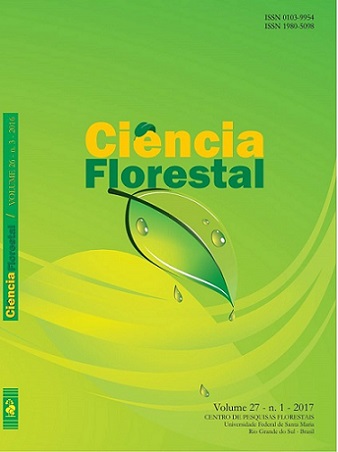FLORISTIC DIVERSITY AND EQUITABILITY IN FOREST FRAGMENTS USING ARTIFICIAL NEURAL NETWORKS
DOI:
https://doi.org/10.5902/1980509826454Keywords:
biological diversity, Brazilian Cerrado, MLP.Abstract
This study aimed to evaluate the predictive efficiency of Shannon index (H') and Pielou Equitability index (J) in forest fragments from the Brazilian Cerrado biome, from the vegetation indices and landscape metrics using artificial neural networks (ANN). Feedforward networks were used and they were trained through a back propagation error algorithm. The variables used as ANN input for simultaneous estimation of indices were: the categorical (H' and J) and the numbers related to the mean and standard deviation of vegetation indices (NDVI, SAVI, EVI, and MVI5, MVI7) and landscape metrics (AREA, GYRATE, SHAPE, CONTIG, CORE and ENN). It was generated five models of ANN from the functional relationships between numerical variables inherent to vegetation indices in two seasons, a dry season (June) and a rainy season (February). The architecture of the networks was the Multilayer Perceptron (MLP), to estimate simultaneously the H' and J: 500 using vegetation indices in the wet season (100 for each vegetation index) and 500 in dry (100 for each vegetation index). The precision, accuracy and realism of biological ANN were assessed. The nets built during the rainy season and dry season that used vegetation indices MVI5 (Moisture Vegetation Index) and SAVI (Soil Adjusted Vegetation Index), respectively, were more appropriate, accurate and biologically realistic to estimate both indices H' and J. The ANN modeling demonstrated to be adequate to estimate the diversity index.
Downloads
References
BLACKARD, J. A.; DEAN, D. J. Comparative accuracies of artificial neural networks and discriminant analysis in predicting forest cover types from cartographic variables. Computers and Electronics in Agriculture, Amsterdam, v. 24, p. 131-151, 1999.
BRADSHAW, C. J. A. et al. Using artificial neural networks to model the suitability of coastline for breeding by New Zealand fur seals (Arctocephalus forsteri). Ecological Modelling, Amsterdam, v. 148, p. 111-131, 2002.
CABACINHA, C. D.; CASTRO, S. S. Relationships between floristic diversity and vegetation indices, forest structure and landscape metrics of fragments in Brazilian Cerrado. Forest Ecology and Management, Amsterdam, v. 257, p. 2157-2165, 2009.
CERQUEIRA, E. O.; ANDRADE, J. C.; POPPI, R. J. Redes neurais e suas aplicações em calibração multivariada. Química Nova, São Paulo, v. 24, n. 6, p. 864-873, 2001.
FERNANDES, A. M. et al. Development of neural network committee machines for automatic forest fire detection using lidar. Pattern Recognition, Amsterdam, v. 37, p. 2039-2047, 2004.
FOODY, G. M.; CUTLER, M. E. J. Mapping the species richness and composition of tropical forests from remotely sensed data with neural networks. Ecological Modelling, Amsterdam, v. 195, p. 37-42, 2006.
GORGENS, E. B. et al. Estimação do volume de árvores utilizando redes neurais artificiais. Revista Árvore, Viçosa, MG, v. 33, n. 6, p. 1141-1147, 2009.
HAYKIN, S. Redes neurais: princípios e prática. 2. ed. Porto Alegre: Bookman, 2001. 900 p.
INGRAM, J. C.; DAWSON, T.; WHITTAKER, R. J. Mapping tropical forest structure in southeastern Madagascar using remote sensing and artificial neural networks. Remote Sensing of Enviroment, Amsterdam, v. 94, p. 491-507, 2005.
KALACSKA, M. et al. Ecological fingerprinting of ecosystem succession: Estimating secondary tropical dry forest structure and diversity using imaging spectroscopy. Remote Sensing of Environment, Amsterdam, v. 108, p. 82-96, 2007.
KUPLICH, T. M. Classifying regenerating forest stages in Amazônia using remotely sensed images and a neural network. Forest Ecology and Management, Amsterdam, v. 234, p. 1-9, 2006.
MABVURIRA, D.; MIINA, J. Individual-tree growth and mortality models for Eucalyptus grandis (Hill) Maiden plantations in Zimbabwe. Forest Ecology and Management, Amsterdam, v. 161, p. 231-245, 2002.
MAEDA, E. E. et al. Predicting forest fire in the Brazilian Amazon using MODIS imagery and artificial neural networks. International Journal of Applied Earth Observation and Geoinformation, Amsterdam, v. 11, p. 265-272, 2009.
MONJEZI, M.; BAHRAMI, A.; VARJANI, A. Y. Simultaneous prediction of fragmentation and flyrock in blasting operation using artificial neural networks. International Journal of Rock Mechanics & Mining Sciences, Amsterdam, v. 47, p. 476-480, 2010.
OLIVEIRA, V. A. et al. Diagnóstico agroambiental do entorno do Parque Nacional das Emas: 1a. Fase, pedologia, aptidão agrícola e uso atual das terras. Gioânia: Agência Rural, 2003.
PESSOA, A. S. A. et al. Mineração de dados meteorológicos para previsão de eventos severos. Revista Brasileira de Meteorologia, São José dos Campos, v. 27, n. 1, p. 61-74, 2012.
SCRINZI, G.; MARZULLO, L.; GALVAGNI, D. Development of a neural network model to update forest distribution data for managed alpine stands. Ecological Modelling, Amsterdam, v. 206, p. 331-346, 2007.
SOARES, F. A. A. M. N. et al. Recursive diameter prediction and volume calculation of eucalyptus trees using Multilayer Perceptron Networks. Computers and Electronics in Agriculture, Amsterdam, v. 78, p. 19-27, 2011.
STATSOFT. Statistica (data analysis software system), version 7. Oklahoma: Statsoft, 2007. Disponível em: <http://www.statsoft.com>. Acesso em: 10 jul. 2013.
TAWADROUS, A. S.; KATSABANIS, P. D. Prediction of surface blast patterns in limestone quarries using artificial neural networks. International Journal for Blasting and Fragmentation, London, v. 10, n. 4, p. 233-242, 2009.







